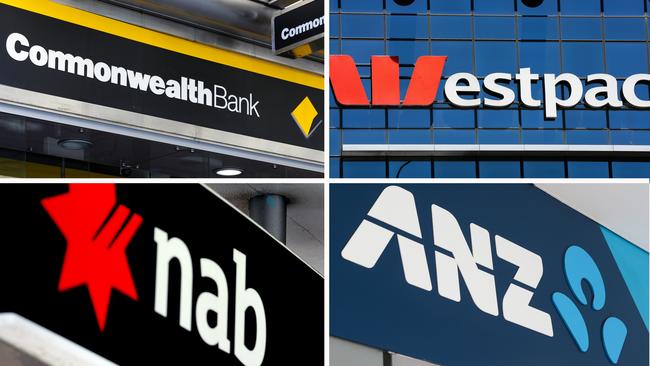Bank margins under pressure as fight for deposits heats up
The benefits of reduced mortgage competition will not yet shine through to earnings when CBA kicks off bank reporting season, as a fight for deposits adds to margin pressure.

The benefits of a recent reduction in mortgage competition will not yet shine through to earnings when Australia’s largest lender kicks off bank reporting season this week, as a fight for deposits adds to margin pressure.
Commonwealth Bank’s full-year result on Wednesday will set the tone for the broader sector, as its three major rivals will provide more limited trading and capital disclosures over coming weeks.
An expected fall in net interest margins, a key measure of profitability that reflects the difference between what banks earn on loans and pay on deposits, will be the focus amid an emerging shortfall in household deposits.
Bad debts will also be in the spotlight. They are expected to rise only moderately because the tight labour market is helping workers cope with the steepest interest rate hikes in decades, despite some areas of strain.
CBA’s cash earnings are expected to be 5.4 per cent higher at $10.1bn, but analysts see net interest margins falling to 2.05 per cent in the six months to June, from 2.1 per cent in the December half.
Fierce competition for mortgages had earlier this year seen banks offer loans below their cost of capital, as $350bn in mortgages roll off low fixed rates to higher variable rates.
NAB is expected to suffer from similar margin pressures when it delivers its trading update for the third quarter on August 15.
“There’s been a lot of headwinds on bank margins recently,” Tyndall Asset Management head of equities Brad Potter said.
“Some of those are alleviating a bit, but the problem is there are lags on those changes so it is going to take a while for that to flow through, so I’m expecting net interest margins to continue to reduce,” he said.
A spike in funding costs has forced banks to refocus on profitability and not so much on volume, offering less discounting. Most major lenders – except ANZ – have stopped generous cashback offers on home loan deals.
Citi banking analyst Brendan Sproules said ANZ had been “keen to show exuberant competition to the ACCC” as it fought to get its bid for Suncorp’s bank approved.
The bid was blocked by the regulator on Friday but the companies will have the decision reviewed by the Competition Tribunal. Suncorp will address investors about its plans at its full-year results on Wednesday.
Bendigo & Adelaide Bank, which the regulator prefers as a buyer of Suncorp’s bank, will post full-year results on August 14. It is expected to reveal that its focus on margin rather than volume has paid off, with net interest margins (NIMs) 20 basis points higher to 1.94 per cent for the year, according to Visible Alpha.

With many economists saying cash rates have peaked, investors will look for a sign of a recovery in NIMs in outlook statements.
“With deposit margins now a headwind, the only realistic method for banks to repair net interest margins will be by limiting the pass-on benefits to customers when a rate-cutting cycle commences,” Martin Currie CIO Reece Birtles said.
“In a persistent or sticky inflation environment, it may take a while for banks to implement this strategy, increasing the risk of lower NIMs persisting,” he said.
Data from the Australian Prudential Regulation Authority last week showed household deposits shrank by $7.7bn in June, the first contraction since May 2021, with analysts warning the declining balances would be likely to trigger a push for higher deposit pricing.
Goldman Sachs lowered its 2023 NIM forecasts for Bank of Queensland to 1.73 per cent from 1.79 per cent in the first half, citing “more elevated deposit cost pressures”.
BOQ, which still offers $3000 cashbacks to new refinancing customers, reports its results on October 11.
With cash rates increasing at the fastest pace since the 1980, the health of the banks’ loan portfolios will come under scrutiny. Given unemployment is near record lows, investors expect only a gradual increase in mortgage arrears.
Last week, BOQ said its non-performing loan balances had risen 18 per cent in the May quarter, reflecting higher arrears in mortgages and other retail exposures. “We expect to see some deterioration for CBA across mortgage arrears, corporate troublesome and impaired assets,” JPMorgan banking analyst Andrew Triggs said. “Nonetheless the pace of deterioration should be gradual.”
ANZ and Westpac will provide quarterly asset quality updates on August 17 and August 21, respectively, but broader earnings results are not expected to be included.
Costs will be another area in focus as services inflation remains stubbornly high.
“Labour costs are the biggest costs banks have and some of the banks are still negotiating enterprise bargaining agreements so there’s upper pressure on that,” Mr Potter said.
NAB and ANZ recently offered their staff wage hikes of 17.5 and 16.5 per cent over four years, respectively.
“And then all the banks have increased compliance and regulatory costs, and those are only going one way, and that is up,” Mr Potter added.
But with solid capital buffers and an attractive dividend yields bank shares have outperformed the market by 3 percentage points in the past three months.
The average major bank trades at a one-year forward dividend yield of about 5.7 per cent, just below the 6 per cent historical average since 2010.
Indeed, at 18.6 times its forward earnings, CBA’s shares are one of the most expensive banking stocks globally. That compares with an average price of 12 times for its three major peers.
The bank is expected to increase its final dividend by 6 per cent to $2.23 per share, which added to the interim dividend will mean a full year payout of $4.32, up 12 per cent.








To join the conversation, please log in. Don't have an account? Register
Join the conversation, you are commenting as Logout